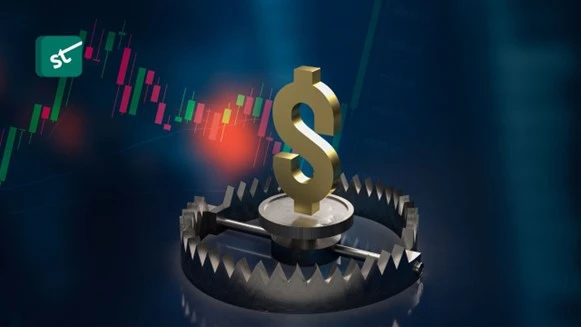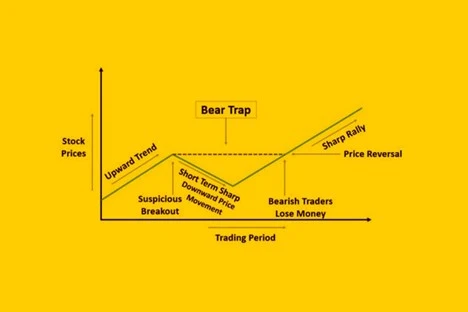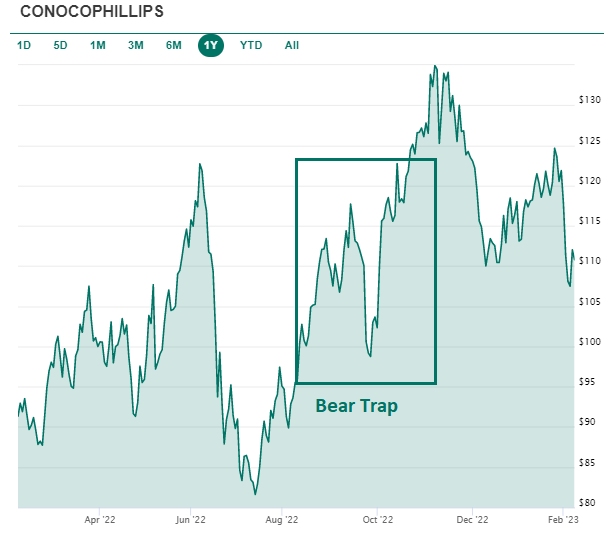Introduction to Bear Trap Stocks
The bear trap stocks is a dangerous pitfall that investors and traders need to be aware of in the ever-changing financial markets.
Those actively involved in trading securities need to closely monitor their portfolios and stay informed of potential risks, especially short-term traders who are always on the lookout for unique windows of opportunity.
The market is divided into two classes of players, namely the bulls and the bears. The bulls follow upward trends and are known to drive up prices.
Alternatively, the bears follow a more pessimistic route, chasing the downturns so as to profit during price falls by short-selling.
It is one example of such a pitfall that retail traders are on the lookout for, given its ability to ensnare the gullible market participant.
At times, even the most technically well-versed retail trader falls for it. If anything, the bear trap stock reinforces the idea that stock analysis is not a science, but rather an art, in which the market can act unexpectedly and irrationally from time to time.
The foresight and on-the-spot thinking of traders are what determine their ability to perform ahead of such traps.
What Is a Bear Trap Stock?
A bear trap stock is essentially the name of a technical market phenomenon that misleads short-sellers by taking a temporary downward shift.
Stocks often experience volatility in either an upward or downward direction. In the case of the trading bear trap, the price curve begins a rapid downward descent, which catches the attention of short sellers, looking to profit from the price loss.

The downward fall is so significant, such that it meets all the technical indicators of a price reversal, pulling in an even greater number of bears to take part in the hammering down of the stock.
Unbeknownst to the bears rushing the stock, the stock was deliberately manipulated to show a falling trend, and the reality is a coordinated misdirection that creates the illusion of a free fall.
The bulls swiftly reverse the direction once enough have entered into short positions, with short-sellers forced to buy back the stock at significant losses, further causing price drive-ups.
Why Is It Called a Bear Trap?
The bear trap stock is named as such because it’s a situation where investors who bet against a stock (like bears) get caught in a trap and lose money. Therefore, by its very nature, the phenomenon actively targets bears.
The trading bear trap pattern in technical analysis occurs when a stock price rises and then falls below a previously established low, creating a downward trend.
This downward trend is deliberately set up like a trap for bearish traders who have bet that the stock price will continue to decline.
As a result, these traders may incur significant losses, much like a bear caught in a trap. Hence the name “bear trap.”
What is Bear Trap Trading?
Now that we know what the bear trap phenomenon entails, we move to look at a class of trading that is built entirely around this concept.
Bear trap trading is basically a stock trading strategy that involves executing trade actions that result in the creation of a bear trap.
Once a reversal is smoothly carried out, market bulls are drawn in by the upward rise, giving additional fuel to the upward momentum. The outcome is a short-term gain that could not have been realized without the ensnaring of short-sellers.
This form of trading is typically carried out by technically-skilled market players, and the victims are often novice traders, who are unable to identify a downward dip from bear trap trading.
It essentially is a manifestation of the idea that stock trading is a zero-sum game where the loss of one class equates to the gain of the other.
How Does It Work?
Bear trap trading works when a group of traders follows a deliberate strategy to sell off stocks to trigger a price fall to attract short-sellers. Once enough have been drawn in, a heavy share drive-up is initiated, causing heavy losses to incur on the short-holders.
In many ways the bear trap works similarly to the short-selling of stocks, however, every bear trap comes with a timed reversal, as a result of which short-holders are forced to sell at a loss.
The following 5 stages take place whenever a bear trap is put to work, in the market:
- Identify a stock on an upward growth trend, with low to moderate levels of trade volume.
- Begin heavily selling off a portion of the identified stock, either independently or in coordination with other bullish traders looking to gain from a bear trap.
- Closely monitor the buying and selling of the stock, along with trade volume. Acting with precise timing is crucial at this stage.
- Once enough bears have been drawn in, begin buying the stock, along with other bears. The intrinsically upward trend would allow for a smooth reversal back to the top.
- Bears will finally begin buying the stock at significant losses, which will further fuel the upward momentum.
What Does the Technical Trading Pattern of a Bear Trap Really Look Like?
On paper, the bear trap stock is straightforward to conceptualize, but identifying the shape of a standard bear trap is of fundamental importance to traders on the lookout for such ploys.
The bear trap pattern is typically identified by a series of price movements in which the stock price rises and then falls below a previously established low, creating a downward trend.
The pattern typically looks like this:

As can be seen on the image above, there are some distinct aspects that relate to the technical trading pattern of a bear trap. These are as follows:
- Initial uptrend: The stock price rises and the trend is bullish.
- Top formation: The stock price reaches a peak and starts to pull back.
- Breakdown: The stock price falls below a previously established low, creating a downward trend.
- Confirmation of bearish trend: The stock price continues to decline, confirming the bearish trend.
- Bear trap trigger: The stock price rises, but then quickly falls back below the previous low, creating a downward trend.
This standard shape is found in all bear trap mechanisms and is often seen frequently on intraday charts, due to the short-term nature of these strategies.
Causes of a Bear Trap
There are a few key things that can cause a bear trap scenario.
-
Lack of information
If investors don’t have all the facts about a company or situation, they may make assumptions that lead to a bear trap.
For example, if there’s been a lot of negative news recently about a company, investors may assume that the stock will keep going down without doing any further research -
Herd Mentality
When everyone else is selling, it can be tempting to do the same thing, even if you don’t have all the information.
This can lead to what’s known as “panic selling,” which can drive the price of a stock down even further and create a bear trap. -
False Hope for a Trend Continuation
The first is when there is a false hope for a trend continuation. This can happen when traders see a sudden spike in price followed by a quick retracement.
They may enter into the market expecting the price to continue moving in the same direction, only to have it quickly reverse and trap them in a losing position. -
Short-Term Thinking
It can be easy to get caught up in the short-term movements of the market, but this can be dangerous for one’s portfolio.
When traders see prices rising and they want to get in on the action, they may take on too much risk in an effort to make a quick profit.
This can backfire if prices then reverse course and they find themselves stuck in a losing trade.
If traders only focus on what’s happening in the next week or month, they could miss out on longer-term opportunities (or pitfalls) -
Overconfidence
When traders feel they are in control of the market and prices are going their way, they may become overconfident and take on too much risk.
This can lead to them being caught in a bear trap when prices unexpectedly turn against them. -
Fundamental Factors
Bear trap stocks can be caused by negative fundamental factors such as poor financial performance, negative news or events impacting the company’s prospects, or weak industry conditions, leading investors to sell off the stock.
However, in some cases, the negative sentiment may be temporary or misunderstood, causing a bear trap when the stock price unexpectedly rebounds.
-
Technical Factors
Technical factors contributing to bear trap stocks can include technical indicators suggesting a downtrend, heavy selling pressure, or a breach of key support levels, attracting bearish traders.
However, sudden positive news or a shift in market sentiment can trigger a reversal, trapping the bears and causing a sharp upward movement in the stock price.
-
Short Selling and Margin Calls
Bear trap stocks can also be influenced by short selling and margin calls, where investors borrow shares to sell them in anticipation of a price decline.
If the stock unexpectedly rises instead, short sellers may be forced to cover their positions, buying back shares at higher prices and creating a surge in demand, ultimately trapping them and causing a short squeeze.
Similarly, margin calls can occur when investors fail to meet the required margin levels, leading to forced liquidation and potential bear trap scenarios.
What Is an Example of a Bear Trap?
One bear trap stock example is when a company’s stock experiences a sudden decline in price due to negative news or poor financial performance. Investors, expecting the downtrend to continue, sell off their shares, creating a bearish sentiment.
However, if the company later announces positive developments or strong earnings results, the stock price may unexpectedly rebound, catching the bearish investors off guard and resulting in a bear trap.
This sudden reversal can cause a rapid increase in the stock’s value, forcing short sellers to cover their positions and leading to a sharp upward movement in the stock price.
How to Identify a Bear Trap Stock?
Given the vicious nature in which bear traps operate, it would do well for investors to precisely identify a situation where such a scenario is likely to play out:
The following are some markers that market participants can use to identify bear trap stocks:
-
Abrupt Surge in Trade Volume
This usually could be seen as irregular trading activity, especially in the case where there are no recent business or market updates that justify such activity.
-
Sudden Price Reversal
When a stock sees a sudden shift in its price trajectory with no apparent catalyst, that is a potential red flag to watch out for.
-
Low Initial Short Interest
A bear trap stock would initially show a low level of short interest before the trap is laid, due to its generally upward nature. This would begin growing extraordinarily after the initial downward price breakdown.
-
Key Support Level and Resistance Level Breakdowns
A potential bear trap may be signaled when a stock’s price breaks below a key support level, indicating a shift in sentiment. Conversely, if it breaks above a resistance level, it could trap bearish traders.
-
Technical Indicators That May Point To a Bear Trap
Bearish moving average crossover, breakdown in chart pattern, or negative oscillator divergence may suggest a bearish trend, but caution is needed as they can also lead to false signals and trap traders.
-
Volume Analysis for Further Confirmation
Low volume during a price decline may indicate weak selling pressure and increase the likelihood of a trap. Conversely, high volume during a downtrend could signal strong selling interest and a higher chance of a bearish continuation rather than a trap.
The Benefits of Trading a Bear Trap Stock
One of the best ways to understand how impactful working with bear trap stocks is, is to go through the benefits it offers to those who deal in them. These are discussed below as follows:
-
Understanding the Potential Return On Investment
Trading a bear trap stock can offer significant potential returns on investment. When correctly identifying a bear trap, investors can take advantage of the sudden reversal in stock price, which often leads to a rapid increase.
By buying the stock at a lower price during the trap and selling it at a higher price when the price rebounds, traders can potentially generate substantial profits.
-
Leveraging Good Timing For Maximum Gains
Trading a stock bear trap requires good timing, as it involves entering the market at the right moment. By recognizing the signs of a bear trap and entering a long position just as the stock price is about to reverse, traders can maximize their gains.
This allows them to capitalize on the upward momentum generated by the bear trap, leading to potentially higher profits compared to those who entered the market earlier or missed the opportunity entirely.
Strategies For Trading A Bear Trap Stock
Knowing strategies for trading a bear trap stock is important because it helps traders navigate and potentially profit from sudden reversals, minimizing losses and maximizing gains in volatile market conditions.
Without a well-defined strategy, traders may fall victim to the trap and face significant financial risks. In light of this, we bring forth some top-notch strategies for trading bear trap stocks below:
-
Recognize the Bear Trap
Traders need to develop the ability to identify bear traps through careful analysis of price patterns, technical indicators, and market sentiment, ensuring they don’t fall into false signals and avoid premature actions.
-
Confirm the Reversal
Before taking action, it’s crucial to wait for confirmation of the bear trap reversal through additional technical signals or positive news. This helps reduce the risk of mistaking a temporary bounce for a genuine upward trend.
-
Manage Risk
Implementing proper risk management techniques, such as setting stop-loss orders and adjusting position sizes, is essential when trading bear trap stocks to limit potential losses in case the reversal does not materialize or the stock price continues to decline.
-
Volume Analysis
Analyzing trading volume can provide further confirmation of a bear trap and help traders gauge the strength and conviction behind the reversal. High volume during the rebound may indicate stronger market participation and increased confidence in the trade.
-
Time Frame Selection
Choosing an appropriate time frame for analysis is important in bear trap trading. Longer time frames help filter out the noise and provide a broader perspective on the stock’s trend, reducing the risk of mistaking short-term fluctuations for a genuine reversal.
-
Fundamental Analysis
Evaluating the underlying fundamentals of the company, such as financial performance, competitive position, and industry trends, can provide a solid foundation for trading bear trap stocks, ensuring a more informed decision-making process.
-
Plan for Profit-Taking
Having a clear profit-taking strategy is crucial to capitalize on the upward movement in bear trap stocks. Setting price targets or using trailing stop orders can help lock in profits and protect against potential market reversals.
-
Monitor Market Conditions
Continuous monitoring of market conditions, including news updates, sector trends, and overall market sentiment, is essential in bear trap trading. This enables traders to adapt their strategies and make informed decisions based on changing market dynamics.
Risks and Rewards of Bear Trap

Bear Trap Stock – Risks
-
Failing to Cause Price Reversal
There always exists the risk that bear trap traders would be unable to cause the price reversal they seek to draw in bears. This case typically results in substantial losses.
-
Mistiming
If the timing is misread at any point during the bear trap, traders could incur heavy losses. This would typically happen if short-sellers already sell the stocks at the initial downward peak before the price climb is even initiated.
-
Bearish Backfire
It sometimes may be the case that bears drawn into the trap overpower the bulls with extraordinary trading volume, which makes an upward reversal impossible to pull off.
-
Volatility
Volatility in bear trap trading poses risks as rapid price fluctuations can lead to unexpected reversals or extended losses, making it crucial for traders to manage their positions effectively and be prepared for sudden shifts in market sentiment.
Risk management is crucial in bear trap stocks to protect against potential losses. Setting appropriate stop-loss orders can limit downside risk, while position sizing and diversification help manage overall portfolio risk.
Additionally, having an exit strategy and adhering to it can prevent prolonged exposure to bear traps and preserve capital for future opportunities.
Bear Trap Stock – Rewards
-
-
Stellar Price Gains
When traders successfully execute bear trap strategies, they gain exposure to heavy price appreciation, which is magnified by bears buying the stock at losses.
-
Greater Understanding of Market Dynamics
Those that regularly engage in trade masterstrokes like the bear trap come to gain expertise in technical market strategies. This comes about through a deeper understanding of the bear and bull dynamic in the market.
-
Bear Trap Stock Chart Example
Now that we have laid out all the nuances surrounding a bear trap, we turn to see what such a phenomenon actually looks like in the real world. We use the example of the Texas-based oil and gas company, ConocoPhillips (NYSE: COP). The company experienced a textbook case of a bear trap in September 2022, which brought significant gains to bulls, and severe losses to bears that fell for the trap.

As can be seen in the image above, the typical bear trap has an N-shaped curve, denoting a rise, then a drastic fall beyond the support level, and then a remarkable price take-off.
In this case, COP’s bullish take-off seemed to have finally broken in mid-September, getting bears active to participate in the anticipated hammering down of the stock.
But in the swift reversal seen above, COP rises to staggering heights, bringing losses to all short-sellers that entered the game after the downward tilt.
15 Ways to Avoid a Bear Trap
Contrary to what many assume, avoiding bear traps does not entail any form of rocket science. Despite the highly technical nature, it is actually easy for traders to avoid falling into such a trap.
-
Look for stocks that have strong fundamentals
A company with a solid business model and strong financials is less likely to be impacted by a bear market.
-
Avoid companies with high debt levels
Companies with a lot of debt are more vulnerable to a downturn in the market.
-
Diversify your portfolio
Don’t put all your eggs in one basket. Invest in a variety of stocks, bonds, and other assets to mitigate risk
-
Have a long-term perspective
Bear markets don’t last forever. If you’re investing for the long haul, take advantage of lower prices to buy quality assets on sale.
-
Avoid entering into short positions
The first rule of thumb is to avoid entering into short positions without solid information that indicates a stock is bound to enter a bearish fall. Without this backing, traders often put themselves into positions of severe risk.
-
Use stop-loss orders
A stop-loss order is an order to sell a security when it reaches a certain price point. This can help limit your losses if the stock price falls sharply.
-
Avoid low-volume stocks
Low-volume stocks must be avoided at all costs, especially when one is looking to enter a short, rather than a long position. These stocks can become part of a rocketing upward growth trend, with relatively low resistance.
Low trading volume also indicates that they are few bears that have identified the opportunity, which severely reduces the probability of it being as promising as one expects. -
Follow Risk Management Principles
Implementing proper risk management techniques such as setting stop-loss orders and diversifying your portfolio can help minimize the impact of bear traps on your investments.
-
Avoid Chasing Hype or Rumors
Making investment decisions based on speculative hype or rumors increases the risk of falling into a bear trap. Instead, focus on thorough research and analysis to make informed decisions.
-
Be Patient and Selective
Avoid rushing into investments and be selective when choosing stocks. Waiting for clear signals and favorable market conditions reduces the likelihood of getting trapped in bearish trends.
-
Seek Professional Advice
Consulting with experienced professionals or financial advisors can provide valuable insights and guidance to navigate potential bear traps and make more informed investment decisions.
-
Use Longer Time Frames
Utilizing longer time frames for analysis can help filter out short-term fluctuations and provide a clearer picture of the stock’s overall trend, reducing the risk of being caught in temporary bearish traps.
-
Monitor Market Sentiment
Keeping a close eye on market sentiment, news, and indicators can help identify potential bear traps and adjust investment strategies accordingly.
-
Focus on Strong Fundamentals
Prioritizing stocks with solid fundamentals, such as strong financial performance and a competitive market position, can increase the likelihood of weathering bear traps and maintaining long-term growth potential.
-
Act Immediately
Finally, if one does get caught up in a bear trap, the next thing to do would be to act immediately, before the losses blow out of proportion.
Quickly getting out of such a scenario would limit one’s losses, and it would be the safest play to go with, rather than waiting for the next downfall.
Bear Trap Vs Bull Trap
As pointed up above, bear trap stocks occur when there is a false indication of a declining market. An inverse phenomenon is the bull trap which is a false indication of a rising market, which explains the core distinction between the bear trap vs bull trap.
Unlike a bear trap, which is a temporary downward movement in stock prices, leading investors to believe that a bearish trend is developing, a bull trap occurs when there is a temporary upward movement in stock prices, leading investors to believe that a bullish trend is forming.
Both the bear trap vs bull trap involve false signals that can lead to losses for traders who fall into the trap. They are mirror inverses of one another and take place in opposite directions to each other.
Conclusion
Bear Traps are vicious market setups that are known to deliver hard blows to bears that get caught up in them.
Those that are opportunistic enough to chase such a bear trap could see tremendous gains, as an upward rise is inevitable for such stocks.
Those entangled on the other side of this, however, must pull out of their positions with no delay, to protect themselves from soaring losses.
In essence, the existence of bear trap stocks calls for traders to focus on the subtle movements of the markets, and in effect, listen to what the market is telling them.
For those that pay attention, the indicators are overwhelmingly apparent.
FAQs
How Long Do Bear Traps Last?
There is typically no set duration for how long a bear trap actually lasts, but in most cases, all phases of the trap take place within a single day. Moreover, the entire N-shaped curve can be executed in a matter of hours. This is due to the short-term and deliberate nature of such traps.
Bear Trap vs. Bull Trap What Is The Difference?
A bear trap is a trading strategy looking to draw in market bears and trap them in the inevitable price rise that follows. The bull trap is the inverse of this approach, whereas market bears attempt to draw in bulls to mislead them by a temporarily rising curve, and then pull off fast-dropping momentum in a short period of time.
Bear Trap vs. Short Sale What Is The Difference?
Bear traps and short sales are similar, in the sense that they involve participants looking to make gains on the downfall of a particular. However, they have a critical difference whereby, in a bear trap, the downward curve is swiftly reversed, resulting in a bullish takeover. In short sales, there is no such upward reversal, and short-sellers continue to profit, the harder the stock falls.
